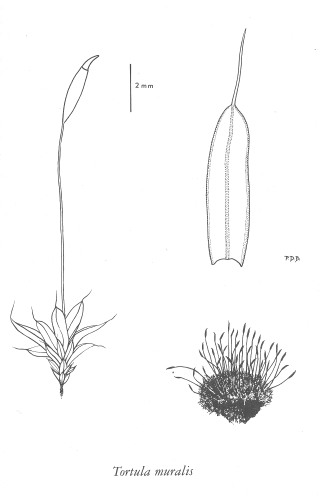Tortula muralis Hedw.
wall screw-moss (tortula moss)
Pottiaceae
Species Account Author: Wilf Schofield
Extracted from Some Common Mosses of BC
Introduction to the Bryophytes of BC
wall screw-moss (tortula moss)
Pottiaceae
Species Account Author: Wilf Schofield
Extracted from Some Common Mosses of BC
Introduction to the Bryophytes of BC
Species Information
Species description:
Species name describing the usual habitat of walls.
Comments:
This is an extremely common species in urban areas and infrequent in natural environments. The abundance of mortar surface and persistence of seasonal moisture no doubt favour it.
Distinguishing characteristics:
The usual habitat on mortar or concrete in urban areas, combined with the white hair points of the leaves and the erect-cylindric sporangia with red, spirally twisted peristome teeth are useful characters.
Habit:
Forming short, reddish-brown (when dry), bluish-green (when humid) to whitish turfs, with the white hair points often dominating the leafy plants.
Similar Species:
T. brevipes is similar to T. muralis but the peristome teeth have a basal cylinder from which the teeth emerge; the teeth in T. muralis lack this tube (shown in the figure of T. princeps). See note under Grimmia pulvinata.
Illustration

If more than one illustration is available for a species (e.g., separate illustrations were provided for two subspecies) then links to the separate images will be provided below. Note that individual subspecies or varietal illustrations are not always available.
Illustration Source: Some Common Mosses of BC
Habitat and Range
Habitat
Frequent on concrete of walls, between stones and bricks and on sandstone cliffs, rarely epiphytic on the trunk bases of Garry oakRange
World DistributionInterruptedly circumpolar in temperate portions of the Northern and Southern Hemispheres; in North America infrequent in the east from Newfoundland to North Carolina and Tennessee and in the west from British Columbia to California, where often abundant.
